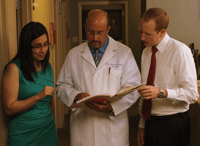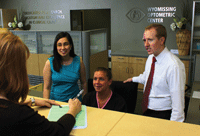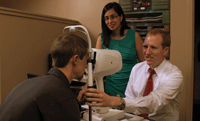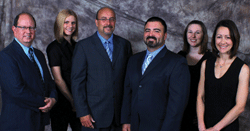If you’re not currently a clinical preceptor for one of the optometry schools, maybe you should become one. I’ve served in this capacity for optometry students for the past 30 years, hosting more than 250 externs in my practice during that time, so I have insights to share about the pros and cons of bringing in externs. (But the pros far outnumber the cons.)

Optometrist Glenn S. Corbin (center) discusses clinical findings with externs Aikaterini Koukas and Joseph Ellwood. Dr. Corbin doesn’t give his externs all the answers. He asks them their opinions to engage them in patient care. Photos: Len Smith/Turning Point Media
Do You Have the Right Stuff?
Before you become a preceptor, reflect on who you are and how you perceive your practice. Are you a very independent practitioner who prefers not to share his or her knowledge with others, or your patients for that matter? If so, this role is not for you.
But if you possess a lot of self-confidence in your ability to teach students, in addition to having a solid academic and clinical knowledge base, preceptorship might serve you well (and vice-versa).
Although your training and experience place you in a position to know more than the students, that doesn’t necessarily make you a good candidate to teach them. You have to be willing to engage them in all aspects of how you provide patient care, and be open to their opinions and approaches to diagnostic and therapeutic decisions.
Remember, this person will be in your office on a daily basis for three or six months, working closely with you and your staff, so know what you’re getting into.
In addition, your patients must be willing to accept that an extern will participate in their care. Only you can make that work. In a teaching hospital or university setting, patients expect to have “student doctors” participating in their care. A teaching practice is no different. Patients usually appreciate the level of expertise that a teaching facility offers, knowing that the doctor will ultimately review their findings, confirm the testing and see them in person to make the decisions on the direction of their care. In my practice, having externs—I refer to them as “interns” because they’re in my office—elevates our practice in the minds of our patients.
What Do Externs Do?
My externs do everything that I do; they practice comprehensive, full-scope optometry. When they first arrive in our office, they receive a one-week orientation to get acquainted with our practice. This gives them time to get to know our staff and the protocols that we follow. Throwing them into patient care immediately would be detrimental to them and to our patients—a formula for disaster.
To start, I give each a thorough tour of the office, and then have them spend several days at my front desk. The reception area is the entry point to our practice, so it’s a natural place to start. Also, it’s a hotbed of activity, where the extern learns all about the “business” of optometry. As a preceptor, your obligation is to not only expose them to clinical care but to train them on all aspects of private practice.
The externs’ time at the front desk gives them an opportunity to hear how the phones are answered, to see how appointments are made and to learn the protocols that my front desk staff uses to triage and address patient issues over the phone. The exposure to the front desk check-in process gives them the opportunity to learn about insurance plans and how we differentiate vision care plans from medical plans. They also observe how patients check out at the end of their visit and learn about pre-appointing and collection of fees.
Next, the externs shadow my clinical techs and learn the pre-testing protocols for the various patient encounters—general exams, contact lens exams, medical eye health visits, emergencies, specialty testing visits, and so on. Once they have some observational opportunities, they switch roles with the techs to perform the pre-testing, while my techs observe and advise them.

Externs should learn not only about clinical care, but about all aspects of private practice. A stint at the front desk shows externs how a practice “really” works.
After the externs have completed this orientation, they spend some time observing one or more of the doctors performing exams. Practices differ in their culture, so the externs need to understand our approach to patient care and how we communicate with our patients. This is critical to integrating an extern successfully into a private practice. For instance, I use very specific language when explaining test results to patients, which the extern would not pick up without shadowing me. I also review the visual test results with the patient, and prescribe lens designs and applications. This discussion with the patient is critical to yielding a higher rate of eyewear purchases.
No matter how much care my externs provide to my patients, I participate at every level. I introduce my extern to the patient and engage them both in the discussion to initiate the exam.
As I examine patients, I discuss clinical findings with the externs and I ask them their opinions to engage them in the patients’ care. Often I ask them to observe through the slit lamp and we discuss the findings in front of the patient, explaining in layman’s terms so the patient is part of the discussion.
At this point, the extern should be ready to start participating in patient care directly. After I exit the exam room, the extern performs a comprehensive refraction, visual analysis and slit lamp exam. They then report their findings to me and we discuss a treatment plan with regard to visual correction. The extern can then discuss the final prescription lens and eyewear options with the patient.
Next, the tech comes in to perform tonometry and dilate the patient, based on the dilation protocol that I provide. Once the patient is dilated, my extern performs a complete ocular health exam, including slit lamp funduscopy and binocular indirect ophthalmoscopy. Afterward, I repeat the eye health testing and perform a final consultation with my patient, along with my extern. Occasionally, a patient prefers to see only you, “the doctor,” not the extern, but that is rare and perfectly acceptable.

Externs should receive hands-on training of testing protocols for various patient encounters—general exams, contact lens exams, medical eye health visits, emergencies, specialty testing visits, and anything else you can throw at them.
In addition to patient care, the externs must adapt to our specific record-keeping forms, protocols, computer software and equipment. Of course, they need to feel comfortable seeing the patients as they learn new administrative protocols. I also have my externs continuously researching diagnoses to help them learn by stimulating discussion. They assist me by drafting my reports to other physicians—a great way for them to review charts, increase their knowledge base and learn what is required to effectively communicate with other doctors, not only eye care practitioners.
Good and Bad
The first few weeks can be trying and frustrating as we break in a new extern. “Patience is a virtue,” I remind myself. Once orientation is complete, life is much easier.
Most externs I’ve encountered over the years have been good or stellar, but occasionally I’ve had a student who is not up to par. This is an extern whose skills lag significantly behind other externs at the same stage of training. Or, this could be a student whose character is a mismatch for your site—a possible detriment to patient care.
I have found, to my dismay, that my colleagues who had these student externs, prior to them coming to my practice, either paid no real attention to them or were just too lenient and pushed them through. Note that I said “too lenient,” not “too nice.” This is a true disservice to the student and our profession.
My expectations for all my externs are the same, but I make some adjustments based on the time of their rotation with me—for example, I treat a third-year student slightly differently than a first-quarter fourth-year student. That being said, some students require more intense training than I should have to provide. I first make every effort to give the student the benefit of the doubt and try to provide extra mentoring. But, if the extern has exhausted my patience and my practice’s ability to move them to the next level, I then contact the college to send the student back for re-assessment and additional on-campus training. But this is rare.
I’m very proud when I see how so many of my prior externs have gone on to be very successful in academia and/or private practice. It’s extremely rewarding to know that I have participated in their success. I have seen many of my former externs throughout the years at conferences, continuing education events and have had the pleasure of attending their lectures as “their” student.
What advice do externs have for you about the process of bringing them
into your practice? Dr. Corbin’s externs offer these suggestions.
• Expect an inquisition. “First and
foremost, a doctor and his staff should be prepared to ask and answer a
lot of questions,” says Joseph Ellwood, class of 2013 at Pennsylvania
College of Optometry. “No amount of education can make up for what a
student lacks in experience. I’ve learned so much by engaging in
dialogue with Dr. Corbin and his staff. Also, working with different
doctors gives us the opportunity to see there are often several
‘correct’ solutions to a presenting problem. I love when doctors ask for
my opinion and then give their reasoning for their approach. I am a
firm believer in the Socratic method.” • Discuss cases daily. “The most
important factor for a successful rotation with an extern is
communication,” says Aikaterini Koukas, also class of 2013 at PCO.
“Discussing cases daily is important in the growth of any extern; it
opens the opportunity for us to ask questions and further research
topics for that day. Even if it’s just discussing cases during lunch or
at the end of the day, it strengthens our ability to manage patients.” • Show them the ropes. “During the first
week, it’s important for the extern to learn the protocol for patient
care,” Ms. Koukas says. “The more exposure we receive about how patient
care is managed, the faster we are to adapt. Letting an extern observe
for one to two days with the doctor helps us understand the flow of
patient care.” • Talk dollars and sense. “In addition to
clinical experiences, Dr. Corbin frequently discusses the business
aspects of his practice,” Mr. Ellwood says. “Not every doctor who
accepts an extern owns a practice, but I’m sure they all have insights
to offer on the business of optometry.”
Tips from the Externs
What’s in it for You?
If you have a busy office and are practicing up to today’s standards both with state-of-the-art technology and clinical scope, becoming a clinical preceptor can bring your practice to the next level. It requires patience, hard work and commitment, but the rewards are plentiful.

Dr. Corbin has hired five former externs who are now full-time doctors in his practice. Pictured (from left) are: Michael Burkhart, O.D., Amanda Legge, O.D., Dr. Corbin, Kerry Burrell, O.D., Karen Heaney, O.D., and Heidi Sensenig, O.D., M.S.
I’ve had the distinct privilege of hiring five of my former externs (one partner and four associates) as full-time members of my practice. I had the ability to spend months working side by side with them, getting to know their personalities and their ability to deal with a variety of situations, and observing their clinical knowledge and skill level. I also share in business discussions with them throughout their rotation and I get to know how knowledgeable they are in this area, as well as their ability to communicate with patients, other health care providers and vendors.
But being a preceptor isn’t merely useful as a way to find a new employee. My experience as a preceptor has made me a better practitioner. To be a good educator, I must stay at the top of my game in every aspect of optometric practice.
I also learn from my externs. They bring up issues that they learned in school or at other sites, triggering me to further investigate and learn new ideas or techniques. I hate to reinvent the wheel and am anxious to learn how someone else approaches patient care so I can improve my care and efficiency.
What’s in it for Your Patients?
When you hear “teaching hospital,” you think “the best.” The same goes for private practice. Patient perception of our practice is elevated when they learn that it is a teaching site. Similarly, when I see my patients after my extern has completed their care, the patients feel like they are getting a second opinion and seem to be more engaged in their care.
What
does it take to qualify to be a preceptor? Each institution varies in
its requirements to participate, but most require you to undergo a
complete personal and professional background check.
They also require
an office profile (instrumentation, number of exam rooms, etc.), patient
profile (demographics, number of exams performed, etc.), educational
opportunities (student support), IT services and photographs of your
office, along with copies of exam forms and office materials.
I query my patients about the care they received from my externs, and they are always forthright in their assessment. As a matter of fact, their comments are usually offered unsolicited. Fortunately, most comments are positive about the clinical care and the extern’s chairside manner.
Criteria to Be a Preceptor
Allay Your Fears
I’ve often heard practitioners say they elect not to have externs because they’re concerned about losing patients, or that their standing with their patients will be downgraded. It is really just the opposite, in my experience. It’s up to the doctor to create the environment that sets a teaching practice apart.
If you think that you might be a good candidate to teach externs and make your practice a teaching site, contact the optometry school of your choice to discuss their clinical programs and opportunities. (I’m a clinical preceptor for the Pennsylvania College of Optometry and the Illinois College of Optometry.) I feel that my participation provides much value to me, my staff and my practice as a whole.
You can benefit from the experience as well. If you’re looking to help shape our profession, what better way than to train our future colleagues?
Dr. Corbin is in private group practice in Wyomissing, Pa.

